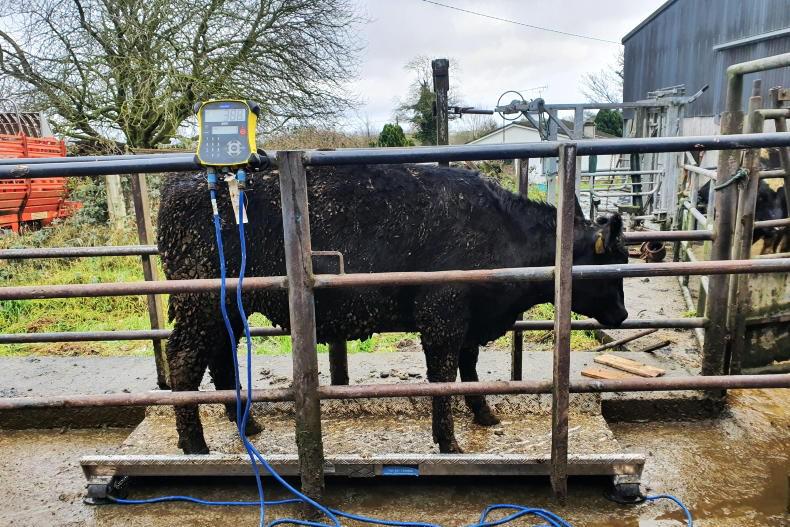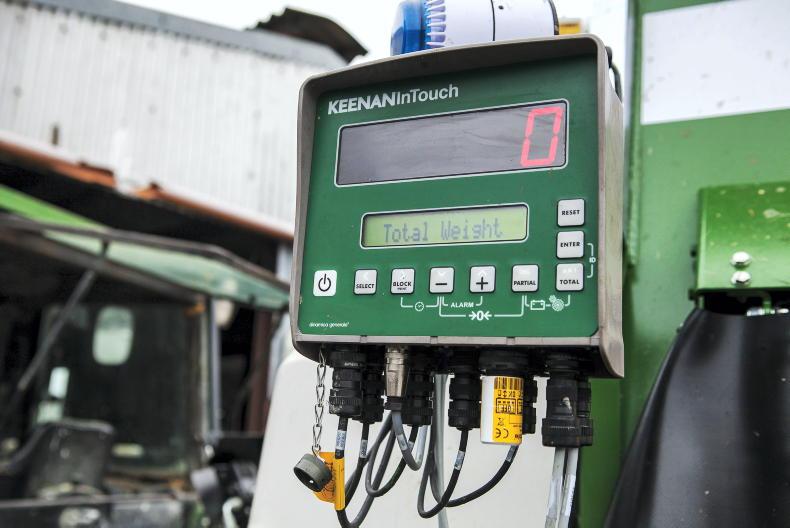Most dairy calf-to-beef farmers are well aware of the benefits of weighing cattle at regular intervals. It is the only accurate barometer of performance available to beef farmers.
Weighing regularly can provide really good information as to how cattle are thriving, and even more importantly, can flag a period of under production much sooner than may be identified where cattle are not being weighed.
Like with any system, the information to come out of it is only as good as the information that is put into it. What I mean by this is that there are many variables that can alter the result of weighing cattle.
Aim to weigh cattle when they are as full as possible. To help ensure this is the case, weigh cattle the day after they have been moved to a fresh paddock.
Take for example a group of 40 yearling bullocks, weighed full prior to turnout in mid-March. They were then grazed in two groups of 20 up until now, which is 10 weeks since turnout.
On the day of weighing, one group had been given a fresh paddock of grass 12 hours prior, while the other group was due to be moved straight after weighing. This could lead to differences in gut fill to the tune of 15kg in this size of animal (greater in heavier cattle).
This difference will result in two very different outcomes. While the true average daily gain of the two groups may not be different at all, in this scenario, group one will have grown 0.2kg/day more than group two.
What might be seen as a period of underperformance is actually an inaccurate weight recording. If cattle are only weighed at times when there is no feed restriction, then the chances of inaccuracies are reduced.
For example, with the weather being experienced at the moment, there is little point in weighing cattle after a period of poor weather, where they have been huddled in the corner of the field for shelter. Cattle are not going to be full in this instance and so will weigh poorly.
When to weigh
On the Thrive demo farm, the aim is to weigh cattle at key points of the year. In the first year as calves, these include arrival, turnout to grass, two weights during the first grazing season and a housing weight.
In the second year, we take a mid-winter weight in late January, a turnout weight, mid-season at grass and then weigh every three weeks for the final two months pre-slaughter.
These weighings often coincide with other routine treatments, so as to avoid extra handling of cattle.
As we approach the end of May, now is a good time to weigh cattle to assess performance since turnout. Difficult grazing conditions and low grass growth may have curtailed performance in some areas, but early-season performance at grass is typically the best of the entire year.
Read more
Thrive weekly roundup: dairy beef sire selection and managing grazing conditions
Wet weather grazing management on beef farms
Thrive: eligible dairy-beef sires for 2022 programme
Most dairy calf-to-beef farmers are well aware of the benefits of weighing cattle at regular intervals. It is the only accurate barometer of performance available to beef farmers.
Weighing regularly can provide really good information as to how cattle are thriving, and even more importantly, can flag a period of under production much sooner than may be identified where cattle are not being weighed.
Like with any system, the information to come out of it is only as good as the information that is put into it. What I mean by this is that there are many variables that can alter the result of weighing cattle.
Aim to weigh cattle when they are as full as possible. To help ensure this is the case, weigh cattle the day after they have been moved to a fresh paddock.
Take for example a group of 40 yearling bullocks, weighed full prior to turnout in mid-March. They were then grazed in two groups of 20 up until now, which is 10 weeks since turnout.
On the day of weighing, one group had been given a fresh paddock of grass 12 hours prior, while the other group was due to be moved straight after weighing. This could lead to differences in gut fill to the tune of 15kg in this size of animal (greater in heavier cattle).
This difference will result in two very different outcomes. While the true average daily gain of the two groups may not be different at all, in this scenario, group one will have grown 0.2kg/day more than group two.
What might be seen as a period of underperformance is actually an inaccurate weight recording. If cattle are only weighed at times when there is no feed restriction, then the chances of inaccuracies are reduced.
For example, with the weather being experienced at the moment, there is little point in weighing cattle after a period of poor weather, where they have been huddled in the corner of the field for shelter. Cattle are not going to be full in this instance and so will weigh poorly.
When to weigh
On the Thrive demo farm, the aim is to weigh cattle at key points of the year. In the first year as calves, these include arrival, turnout to grass, two weights during the first grazing season and a housing weight.
In the second year, we take a mid-winter weight in late January, a turnout weight, mid-season at grass and then weigh every three weeks for the final two months pre-slaughter.
These weighings often coincide with other routine treatments, so as to avoid extra handling of cattle.
As we approach the end of May, now is a good time to weigh cattle to assess performance since turnout. Difficult grazing conditions and low grass growth may have curtailed performance in some areas, but early-season performance at grass is typically the best of the entire year.
Read more
Thrive weekly roundup: dairy beef sire selection and managing grazing conditions
Wet weather grazing management on beef farms
Thrive: eligible dairy-beef sires for 2022 programme









SHARING OPTIONS